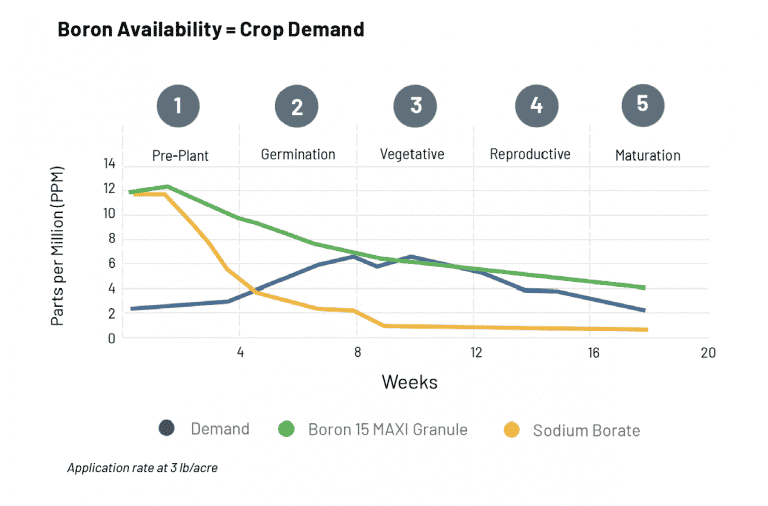Granular Micronutrients
Timing:
SoilNutrient Type:
Macronutrient
Granular
Why a Soil Micronutrient?
The word Micro can leave an impression that these nutrients are not as important to maximize crop production. However, even though the amount required by the crop is small relative to a macronutrient (Nitrogen, Phosphorus and Potassium) the implications of limiting one or more of these essential nutrients can have a dramatic impact on the yield of the crop.
Over the previous number of decades stewardship to micronutrient management has not been a top priority giving rise that our soils being depleted with nutrient removal exceeding application rates. However, over the last decade there has been a significant increase in micronutrient management as we need to drive the genetic yield potential of the crop.
One of the challenges is most of the micronutrients (Zinc, Manganese, Copper and Iron) (with the exception being Boron) have limited mobility in the soil meaning deficiencies can show up immediately in the young seedlings.
To ensure the plant does not ever become micronutrient deficiency it is critical to do a soil application using the proper form and placement to optimize nutrient uptake and efficiency by the plant.
The 8 key micronutrients include Zinc, Boron, Manganese, Copper, Iron, Chloride, Molybdenum, and Nickel.
There are a number of benefits of using a soil micronutrient that include (but not limited to);
- Optimize multiple enzymatic processes to maximize photosynthesis.
- Maximize rooting by the crop.
- Ensure proper cell wall and membrane formation in both the roots and leaves of the plant.
- Compliment Nitrogen, Phosphorus, Potassium and Sulphur nutrition to keep all essential nutrients in balance.
- Important for abiotic stress tolerance
- Maintain optimum plant health to help the young plants ward off invasion by pathogen and insects (biotic stress).
- In most situations, the micronutrient can be blended with a soil macronutrient program.
To confirm if a micronutrient application is required, it is recommended to do a complete soil analysis for each field. Be sure to include the crop being grown when performing the soil sample as each crop is unique in their micronutrient requirements.
Related Articles

How do you prevent a “herbicide hangover”?
How do you prevent a “herbicide hangover”? Due to the environmental conditions this year, the growth of the crop has been slower than normal, resulting

Boost Yield and Crop Quality with Zinc
Want to boost yield and the quality of your crop? You’re going to need a little Zinc. Find out why this essential nutrient is one

Are your crops begging for boron?
Globally, boron deficiency is one of the most prevalent micronutrient deficiencies, and Western Canada is not an exception. Boron deficiency is on the rise with
ATP offers a complete portfolio of granular micronutrients to address the most common micronutrient deficiencies that exist in the soil.
The product line has been put together to ensure proper solubility for plant available nutrition, while maximizing feeding sites and ensuring seedling safety. The different formulations also allows for a wider use pattern.
- Boron 10 and 15% are derived from Ulexite (a combination of sodium borate and Calcium borate) for improved seedling safety while providing immediate availability, along with season long supply to the crop.
- Boron offered in 2 different analyses to provide the option for increased feeding sites with the 10% product.
- Copper 12 and EZ20 have a high percentage of soluble and plant available nutrients, (65% and 70%, respectively) ensuring early season availability with the extra value of seedling safety.
- The low analysis in Copper 12 and EZ20 allows for an increase in the number of feeding sites (more granules per acre) for the plant to access.
- Copper 12 is also formulated with 6% Zinc.
- Zinc and manganese sulphate are 100% soluble and plant available, blendable with other nutrients, that can be applied in furrow, side band or broadcast.
Proven Agronomic Performance

Technical Info
| PRODUCT | ANALYSIS | RATE | TIMING | FORM | PRODUCT SIZE |
|---|---|---|---|---|---|
| 10B | 10-20 product/acre | Soil | Granular | 22.7 Kg, 907Kg | |
| 15B | 6.7-13.4 product/acre | Soil | Granular | 22.7 Kg, 907Kg |
| 12Cu-6Zn-13S | 8.3-16.6 product/acre | Soil | Granular | 22.7 Kg, 907Kg | |
| 32Mn-15S | 3.1-6.2 product/acre | Soil | Granular | 22.7 Kg, 907Kg | |
| 35.5Zn-17.5S | 2.8-5.6 product/acre | Soil | Granular | 22.7 Kg, 907Kg | |
| 2-0-0-20Zn-14S | 5-10 product/acre | Soil | Granular | 22.7 Kg, 907Kg |
Product Recommendations:
- Contact your local ATP representative for the maximum seed placed rates.




